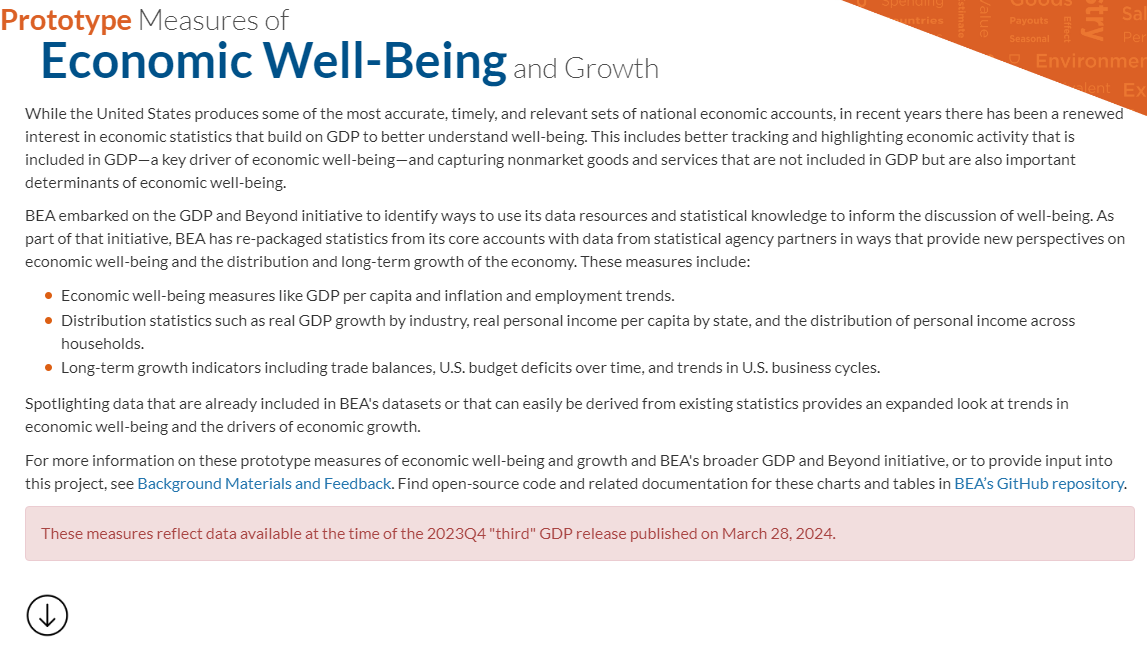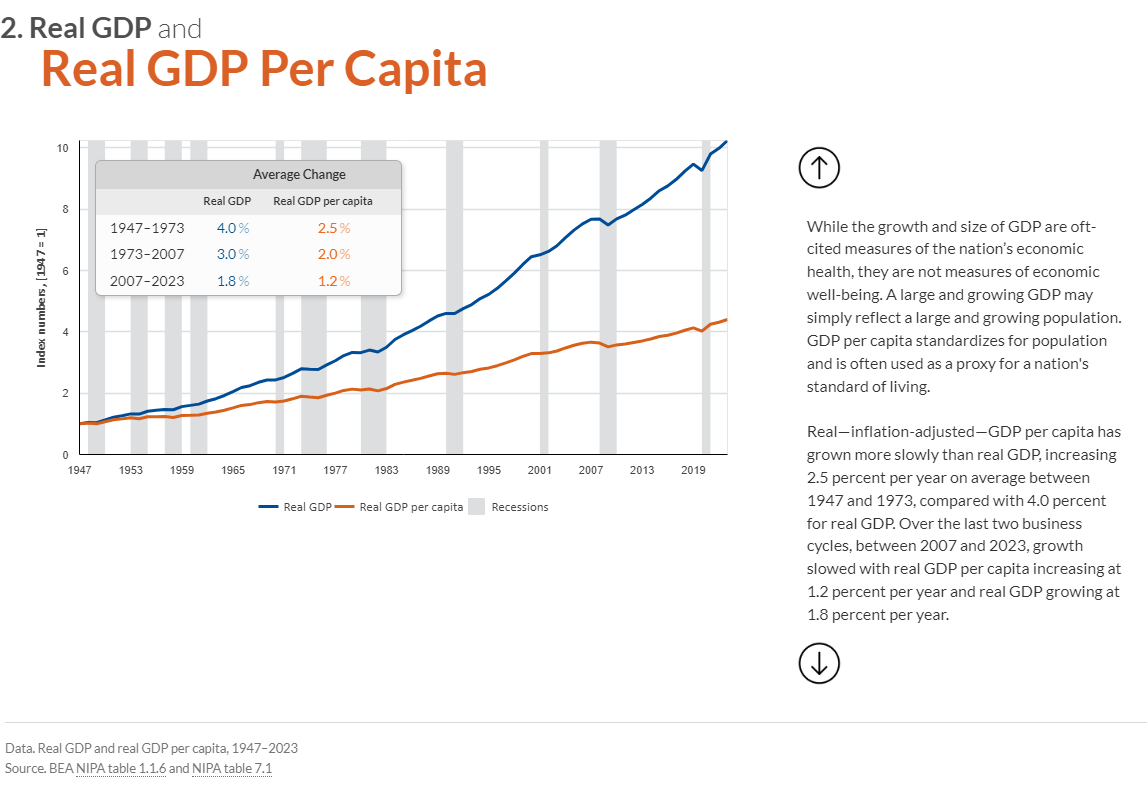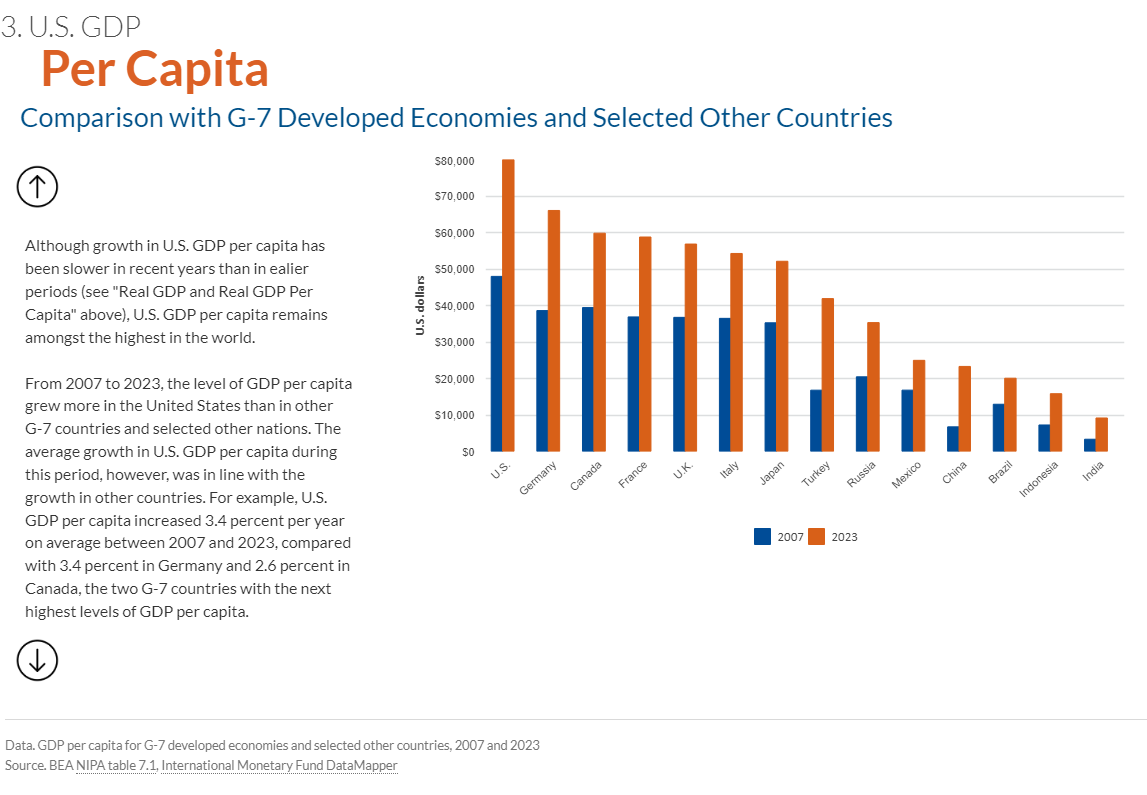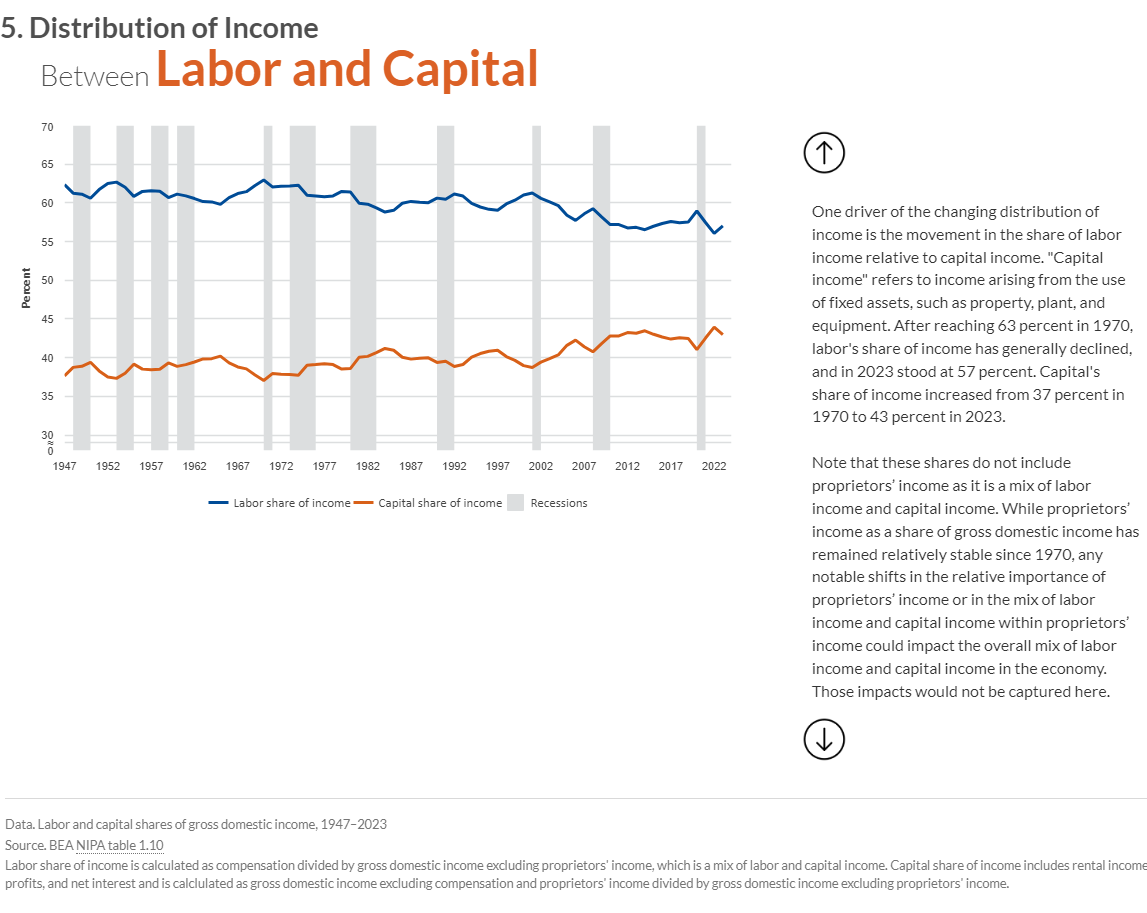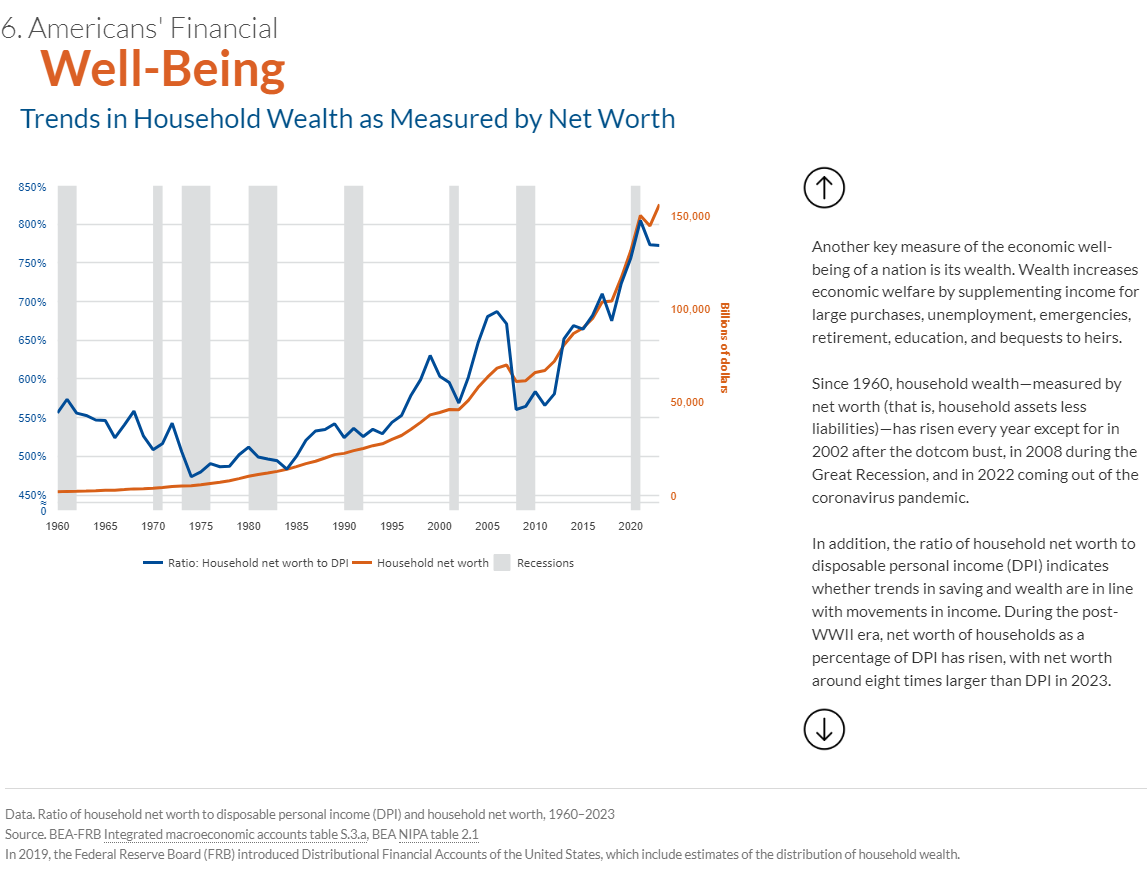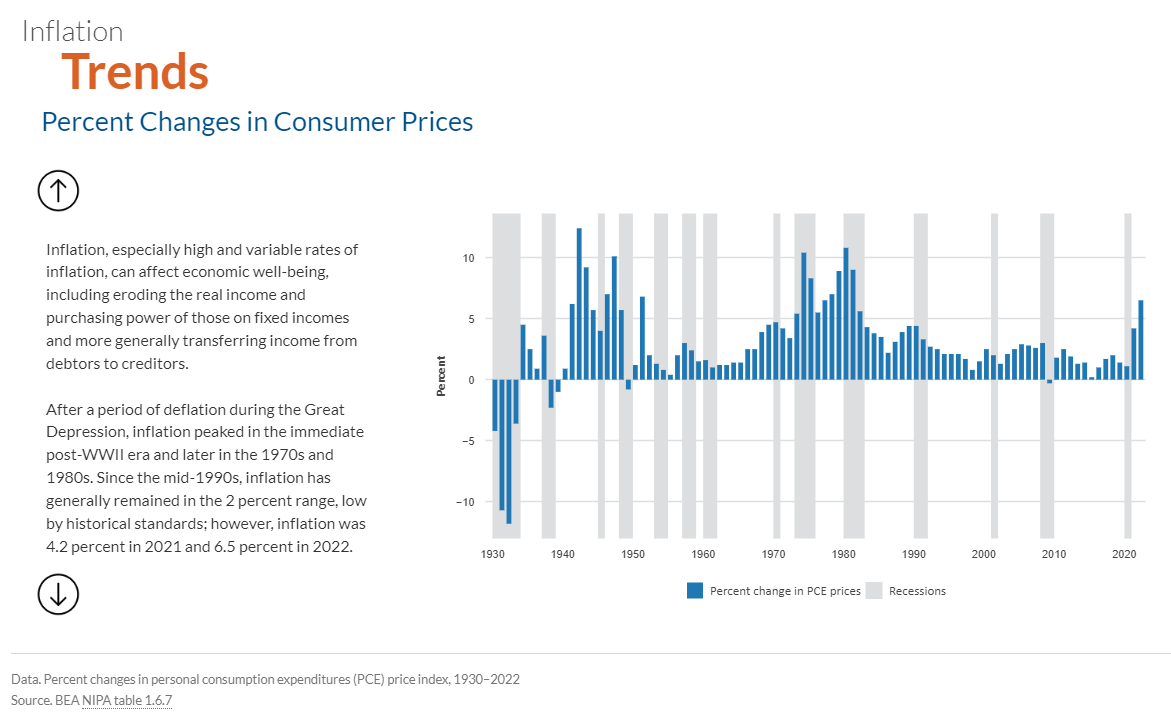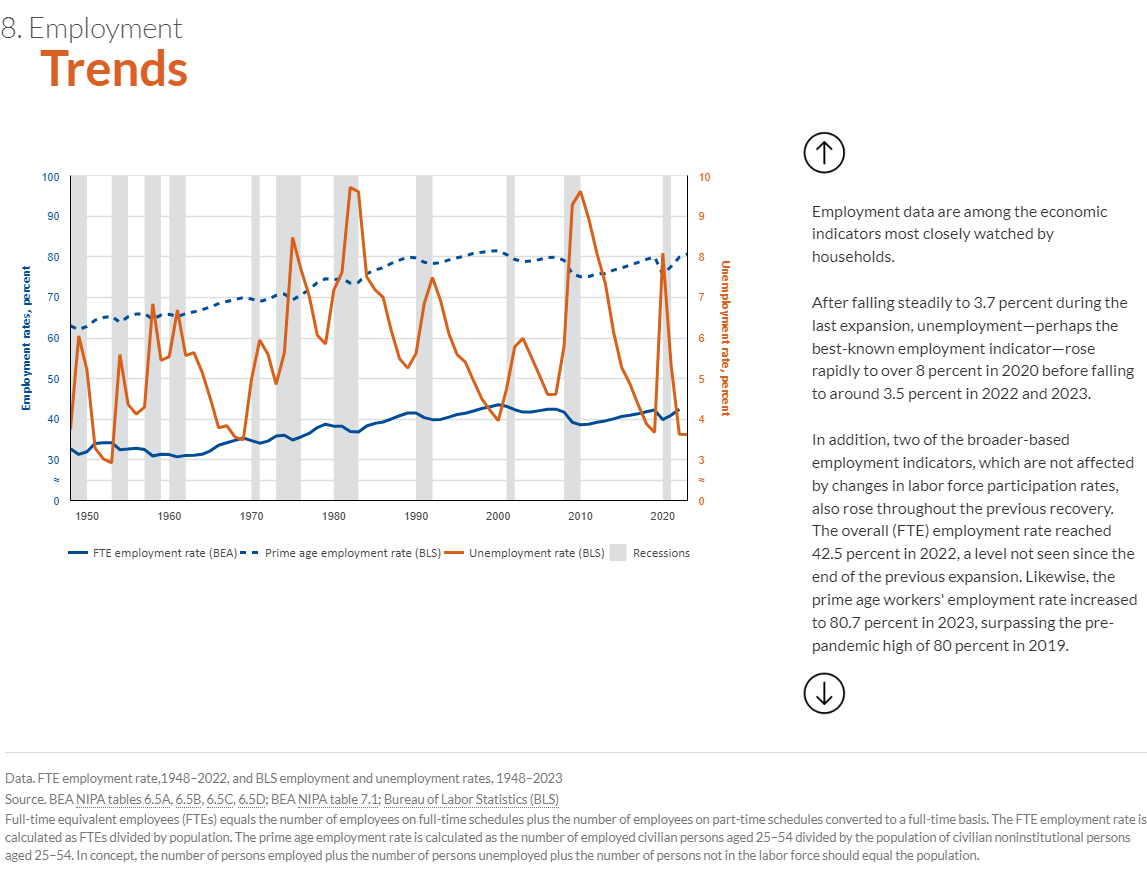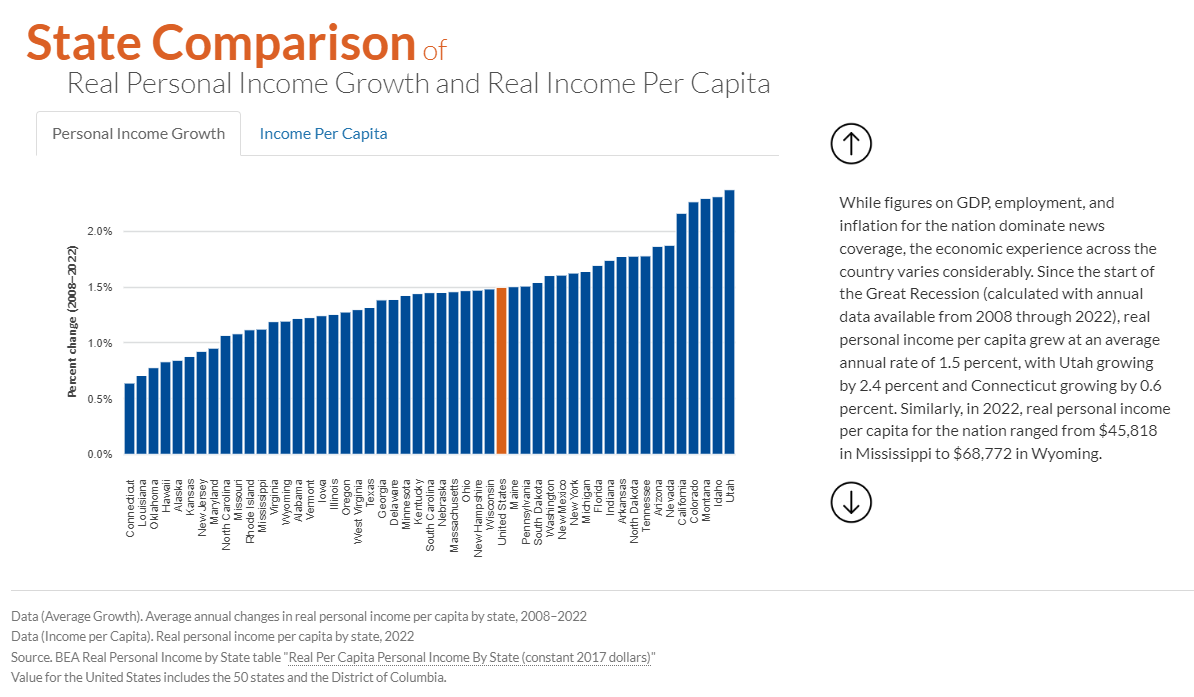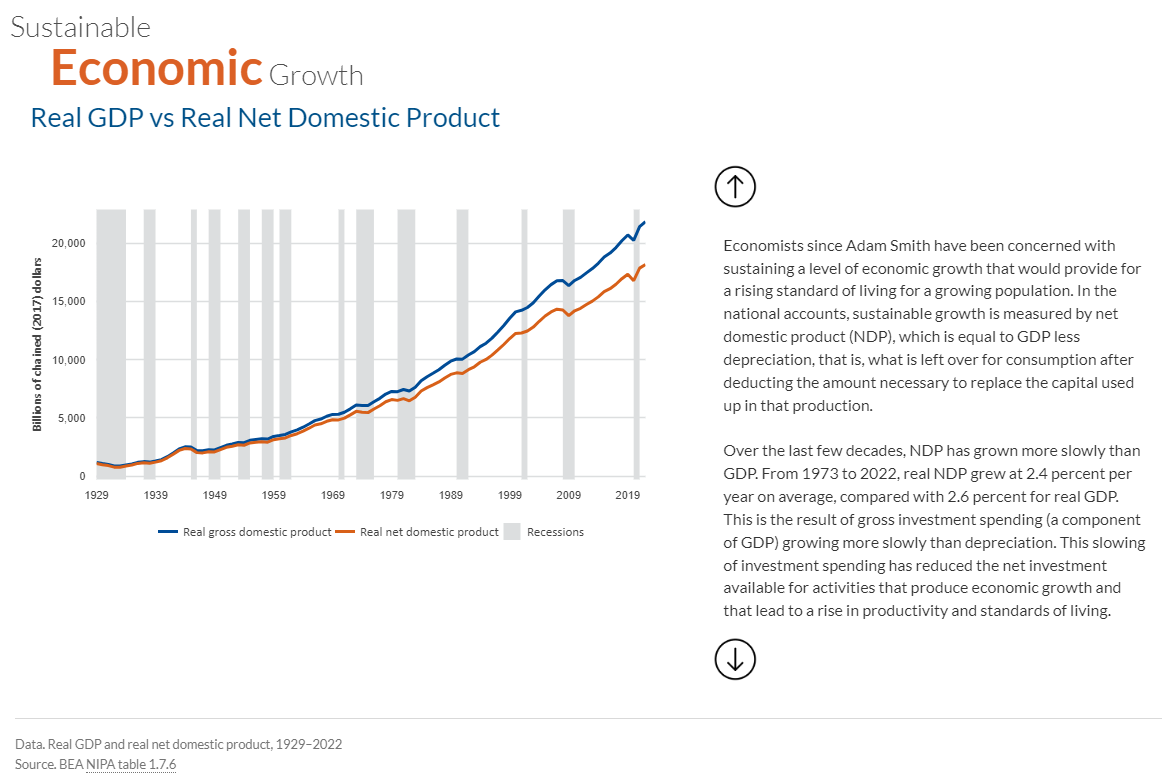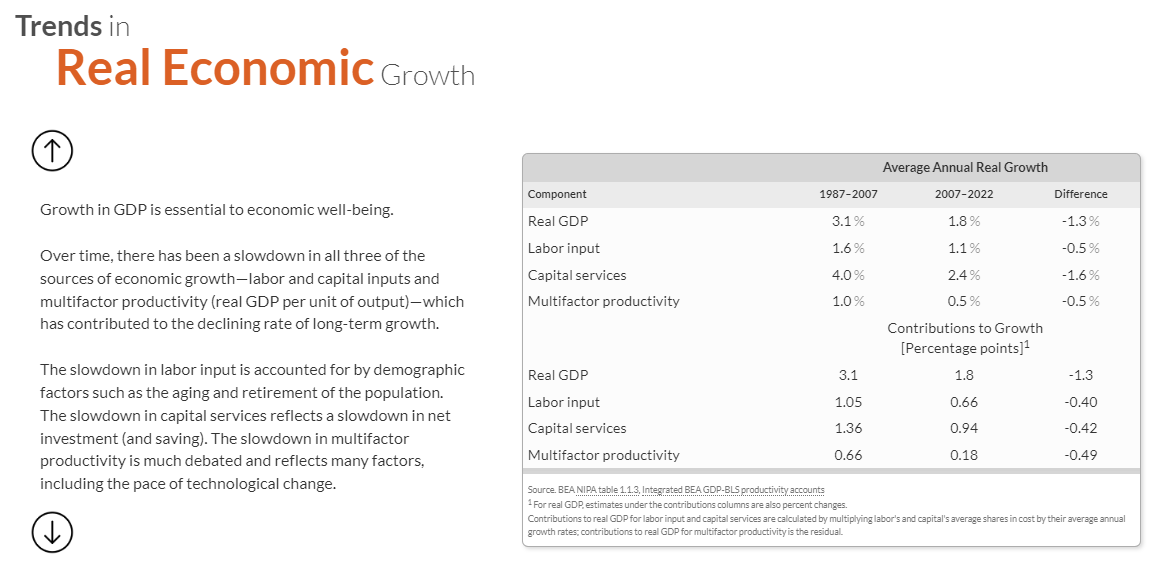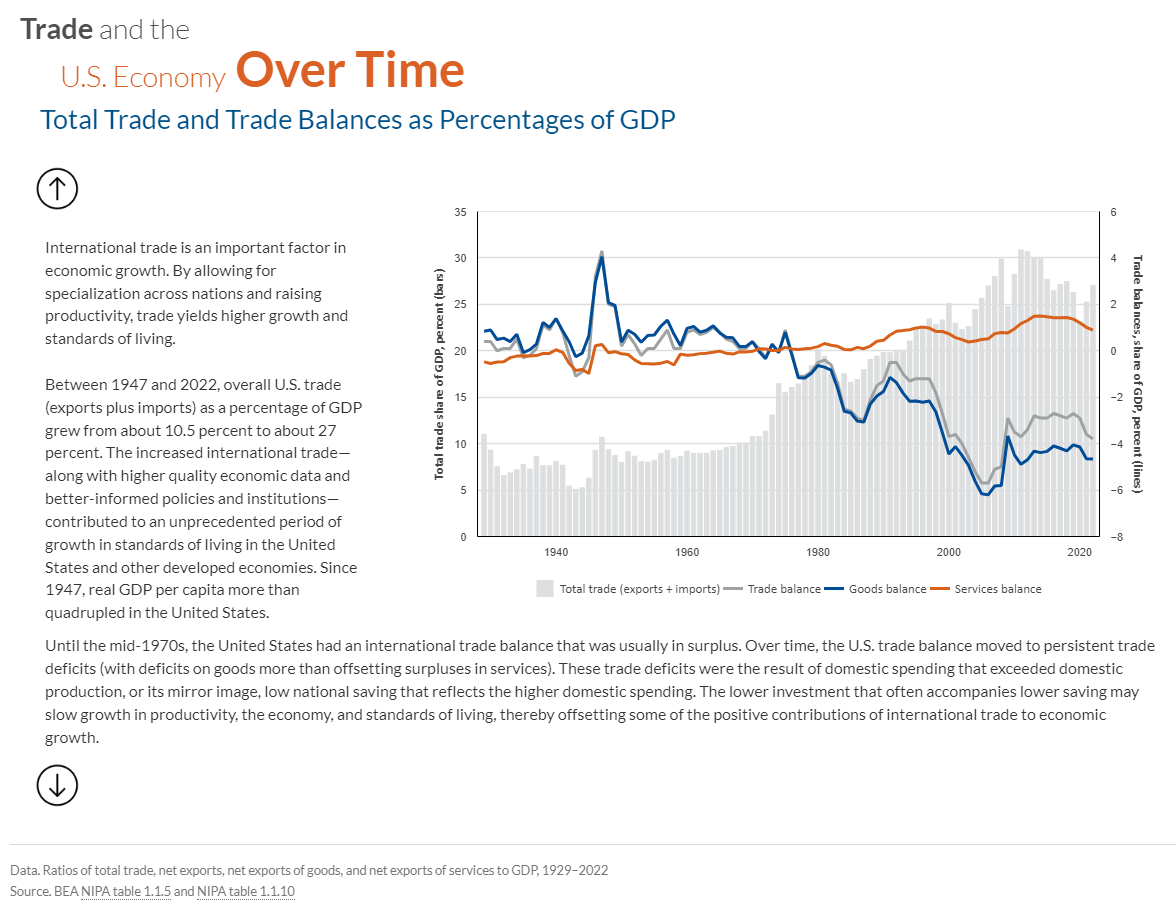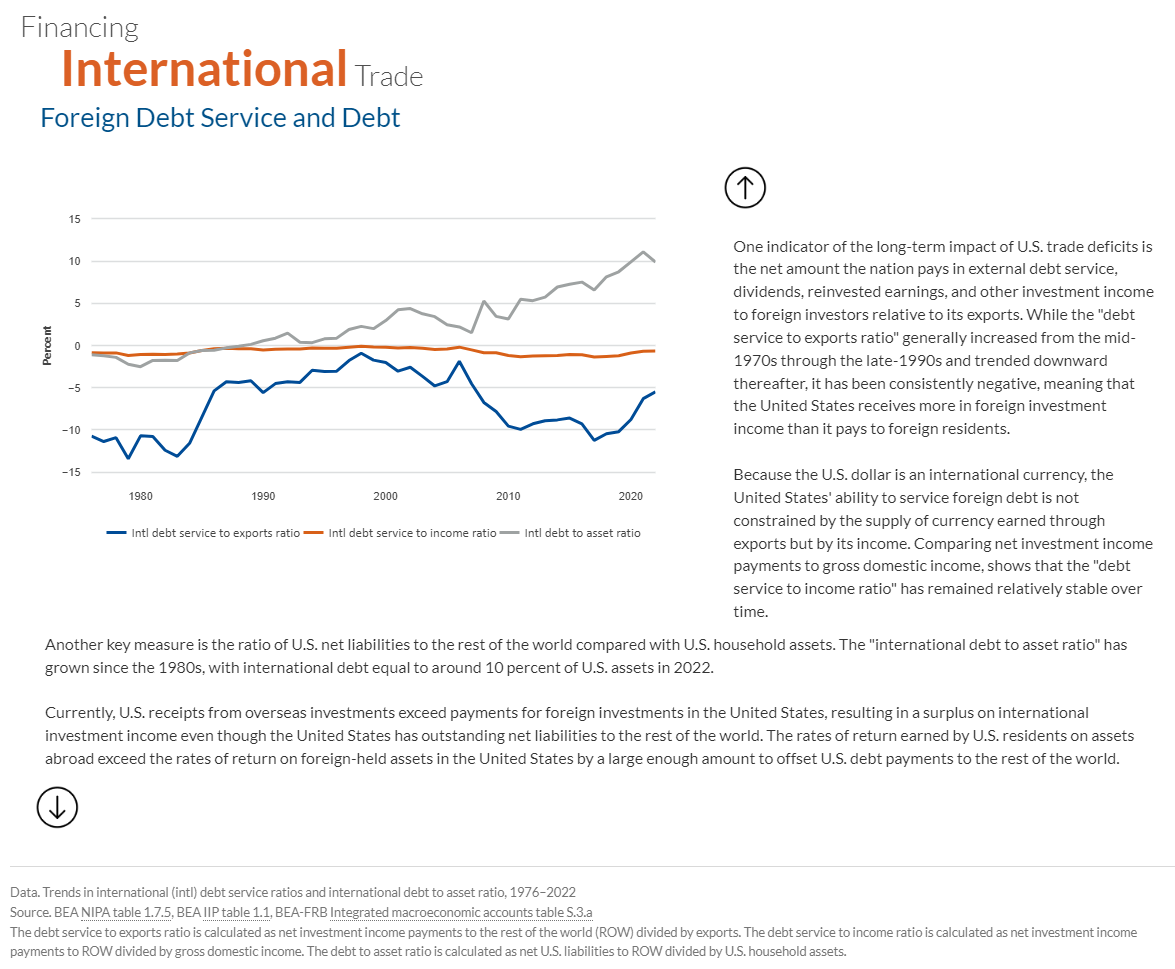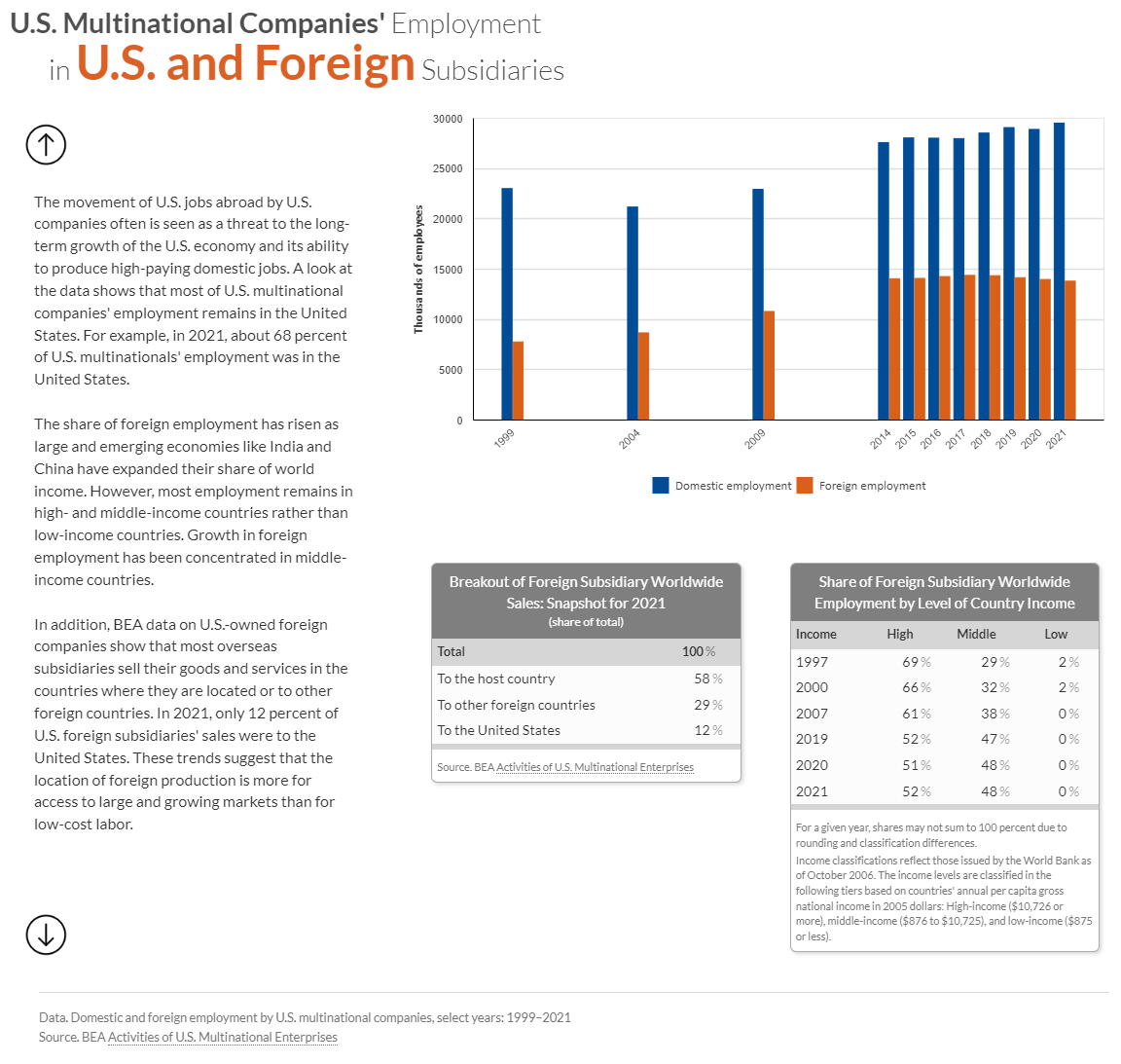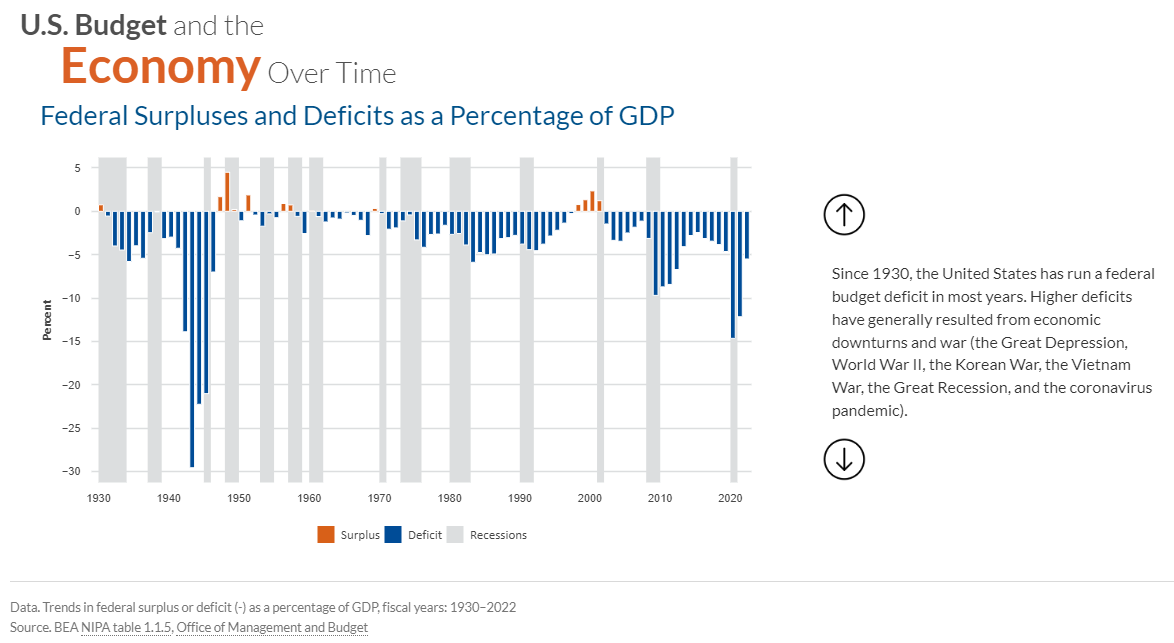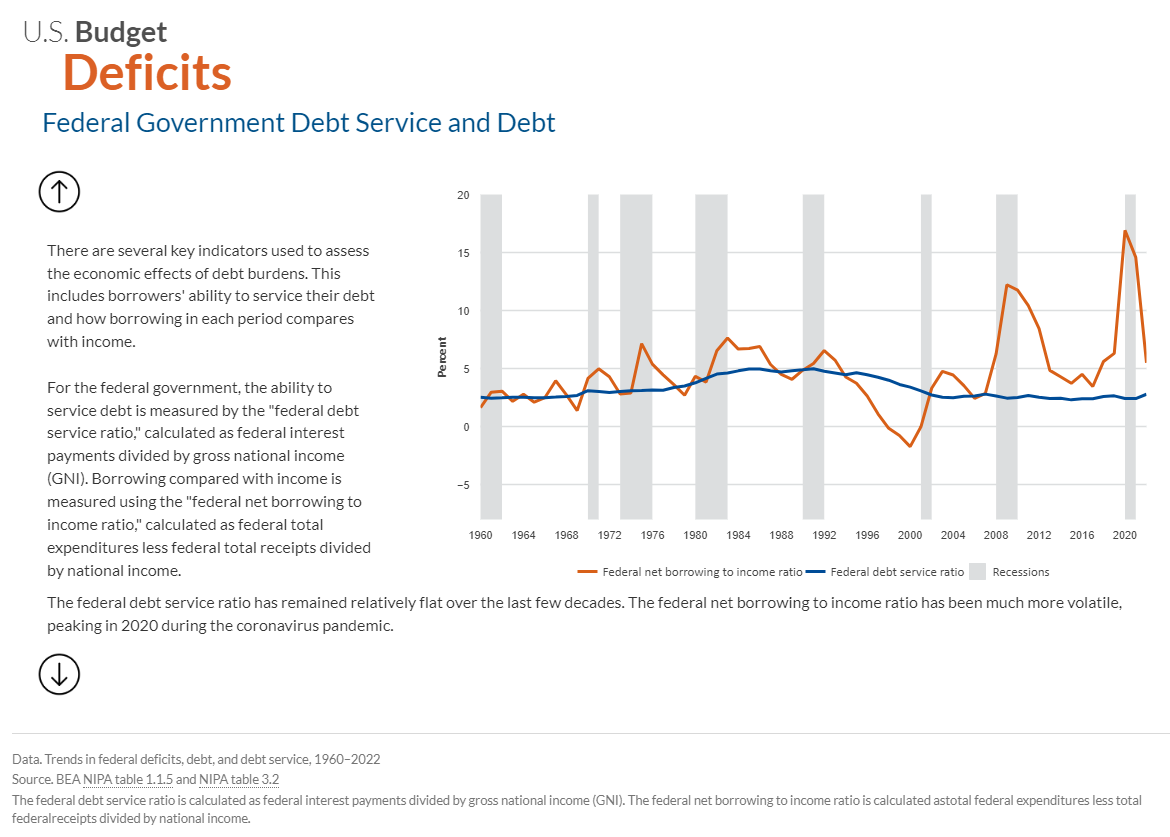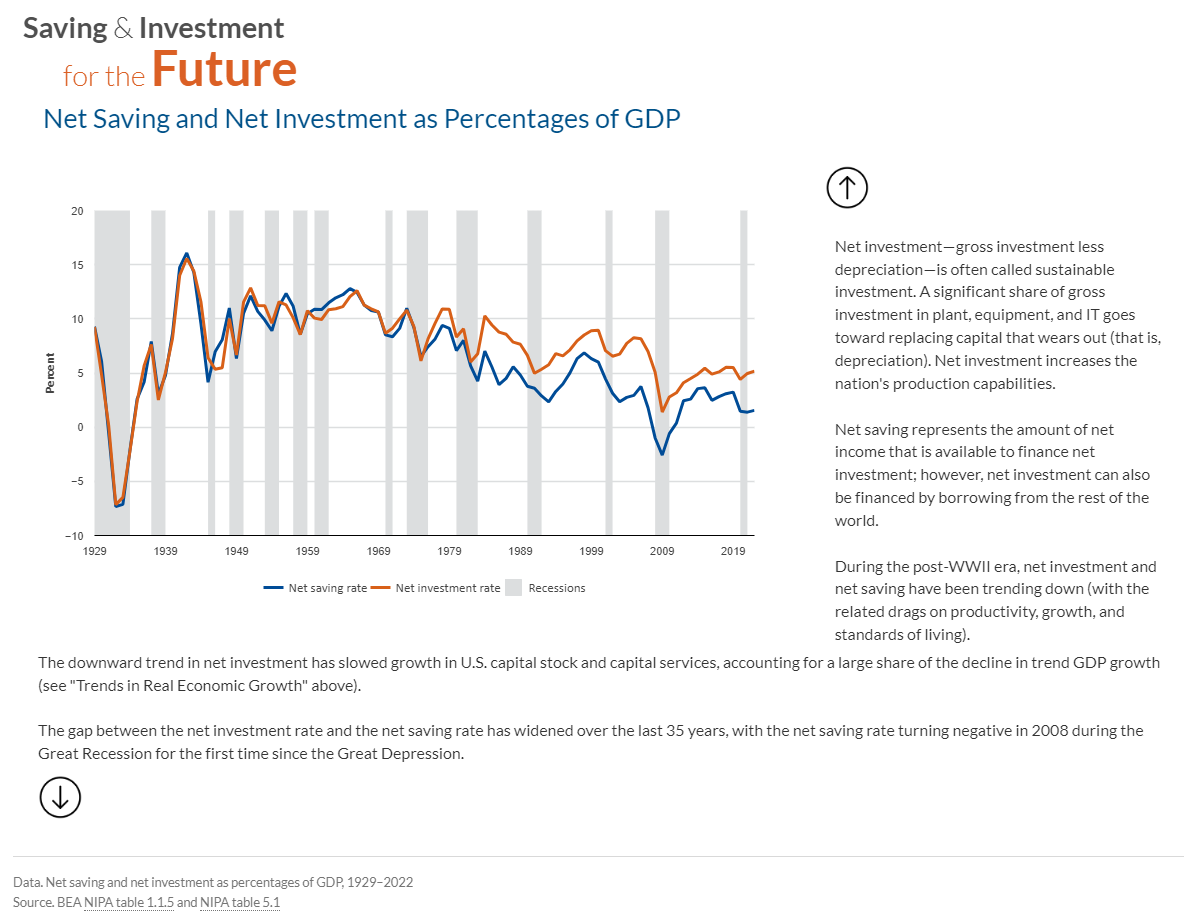Prototype Measures of
Economic Well-Being and Growth
Posted: March 2025
While the United States produces some of the most accurate, timely, and relevant sets of national economic accounts, in recent years there has been a renewed interest in economic statistics that build on GDP to better understand well-being. This includes better tracking and highlighting economic activity that is included in GDP—a key driver of economic well-being—and capturing nonmarket goods and services that are not included in GDP but are also important determinants of economic well-being.
BEA embarked on the GDP and Beyond initiative to identify ways to use its data resources and statistical knowledge to inform the discussion of well-being. As part of that initiative, BEA has re-packaged statistics from its core accounts with data from statistical agency partners in ways that provide new perspectives on economic well-being and the distribution and long-term growth of the economy. These measures include:
- Economic well-being measures like GDP per capita and inflation and employment trends.
- Distribution statistics such as real GDP growth by industry, real personal income per capita by state, and the distribution of personal income across households.
- Long-term growth indicators including trade balances, U.S. budget deficits over time, and trends in U.S. business cycles.
Spotlighting data that are already included in BEA's datasets or that can easily be derived from existing statistics provides an expanded look at trends in economic well-being and the drivers of economic growth.
For more information on these prototype measures of economic well-being and growth and BEA's broader GDP and Beyond initiative, or to provide input into this project, see Background Materials and Feedback. Find open-source code and related documentation for these charts and tables in BEA’s GitHub repository.
2. Real GDP and
Real GDP Per Capita
| Average Change | ||
|---|---|---|
| Real GDP | Real GDP per capita | |
| 1947–1973 | 4.0% | 2.5% |
| 1973–2007 | 3.0% | 2.0% |
| 2007–2023 | 1.8% | 1.2% |
Real—inflation-adjusted—GDP per capita has grown more slowly than real GDP, increasing 2.5 percent per year on average between 1947 and 1973, compared with 4.0 percent for real GDP. Over the last two business cycles, between 2007 and 2023, growth slowed with real GDP per capita increasing at 1.2 percent per year and real GDP growing at 1.8 percent per year.
- Data. Real GDP and real GDP per capita, 1947–2023
- Source. BEA NIPA table 1.1.6 and NIPA table 7.1
3. U.S. GDP
Per Capita
Comparison with G-7 Developed Economies and Selected Other Countries
From 2007 to 2023, the level of GDP per capita grew more in the United States than in other G-7 countries and selected other nations. The average growth in U.S. GDP per capita during this period, however, was in line with the growth in other countries. For example, U.S. GDP per capita increased 3.4 percent per year on average between 2007 and 2023, compared with 3.4 percent in Germany and 2.6 percent in Canada, the two G-7 countries with the next highest levels of GDP per capita.
- Data. GDP per capita for G-7 developed economies and selected other countries, 2007 and 2023
- Source. BEA NIPA table 7.1, International Monetary Fund DataMapper
4. Real Income Growth
and Its Distribution
Real GDP per capita spreads total production across the entire population equally.
Alternatively, real median equivalized personal income—that is, adjusted for household size—provides an inflation-adjusted measure of total income received by the “middle” income household, whose income is below 50 percent of households and above the other 50 percent of households.
Real median personal income is a more appropriate gauge of how the U.S. economic pie is distributed because it focuses on how income accrues to households rather than on GDP, which is a measure of production.
| Average Change | ||
|---|---|---|
| Real GDP per capita |
Real median equivalized personal income |
|
| 2007–2022 | 1.1% | 1.3% |
- Data. Real GDP per capita and real median equivalized personal income in 2017 dollars, 2000–2022
- Source. BEA NIPA Table 7.1, BEA Distribution of personal income estimates
- In addition to differences related to the concepts of "median" and "mean" and between GDP and personal income, there are other important conceptual differences between GDP per capita, median personal income, and other available measures of the distribution of income (like those produced by the Census Bureau).
5. Distribution of Income
Between Labor and Capital
Note that these shares do not include proprietors’ income as it is a mix of labor income and capital income. While proprietors’ income as a share of gross domestic income has remained relatively stable since 1970, any notable shifts in the relative importance of proprietors’ income or in the mix of labor income and capital income within proprietors’ income could impact the overall mix of labor income and capital income in the economy. Those impacts would not be captured here.
- Data. Labor and capital shares of gross domestic income, 1947–2023
- Source. BEA NIPA table 1.10
- Labor share of income is calculated as compensation divided by gross domestic income excluding proprietors' income, which is a mix of labor and capital income. Capital share of income includes rental income, profits, and net interest and is calclulated as gross domestic income excluding compensation and proprietors' income divided by gross domestic income excluding proprietors' income.
6. Americans' Financial
Well-Being
Trends in Household Wealth as Measured by Net Worth
Since 1960, household wealth—measured by net worth (that is, household assets less liabilities)—has risen every year except for in 2002 after the dotcom bust, in 2008 during the Great Recession, and in 2022 coming out of the coronavirus pandemic.
In addition, the ratio of household net worth to disposable personal income (DPI) indicates whether trends in saving and wealth are in line with movements in income. During the post-WWII era, net worth of households as a percentage of DPI has risen, with net worth around eight times larger than DPI in 2023.
- Data. Ratio of household net worth to disposable personal income (DPI) and household net worth, 1960–2023
- Source. BEA-FRB Integrated macroeconomic accounts table S.3.a, BEA NIPA table 2.1
- In 2019, the Federal Reserve Board (FRB) introduced Distributional Financial Accounts of the United States, which include estimates of the distribution of household wealth.
7. Inflation
Trends
Percent Changes in Consumer Prices
After a period of deflation during the Great Depression, inflation peaked in the immediate post-WWII era and later in the 1970s and 1980s. Since the mid-1990s, inflation has generally remained in the 2 percent range, low by historical standards; however, inflation was higher coming out of the coronavirus pandemic, peaking at 6.5 percent in 2022 before falling to 3.7 percent in 2023.
- Data. Percent changes in personal consumption expenditures (PCE) price index, 1930–2023
- Source. BEA NIPA table 1.6.7
8. Employment
Trends
After falling steadily to 3.7 percent during the last expansion, unemployment—perhaps the best-known employment indicator—rose rapidly to over 8 percent in 2020 before falling to around 3.5 percent in 2022 and 2023.
In addition, two of the broader-based employment indicators, which are not affected by changes in labor force participation rates, also rose throughout the previous recovery. The overall (FTE) employment rate reached 42.5 percent in 2022, a level not seen since the end of the previous expansion. Likewise, the prime age workers' employment rate increased to 80.7 percent in 2023, surpassing the pre-pandemic high of 80 percent in 2019.
- Data. FTE employment rate,1948–2022, and BLS employment and unemployment rates, 1948–2023
- Source. BEA NIPA tables 6.5A, 6.5B, 6.5C, 6.5D; BEA NIPA table 7.1; Bureau of Labor Statistics (BLS)
- Full-time equivalent employees (FTEs) equals the number of employees on full-time schedules plus the number of employees on part-time schedules converted to a full-time basis. The FTE employment rate is calculated as FTEs divided by population. The prime age employment rate is calculated as the number of employed civilian persons aged 25–54 divided by the population of civilian noninstitutional persons aged 25–54. In concept, the number of persons employed plus the number of persons unemployed plus the number of persons not in the labor force should equal the population.
9. Industry Comparison
of Real Economic Growth
- Data. Average annual changes in real value added by industry, 2020Q2–2023Q4
- Source. BEA GDP by Industry table "Chain-Type Quantity Indexes for Value Added by Industry"
10. State Comparison of
Real Personal Income Growth and Real Income Per Capita
- Data (Average Growth). Average annual changes in real personal income per capita by state, 2008–2022
- Data (Income per Capita). Real personal income per capita by state, 2022
- Source. BEA Real Personal Income by State table "Real Per Capita Personal Income By State (constant 2017 dollars)"
- Value for the United States includes the 50 states and the District of Columbia.
11. Sustainable
Economic Growth
Real GDP vs Real Net Domestic Product
Over the last few decades, NDP has grown more slowly than GDP. From 1973 to 2023, real NDP grew at 2.4 percent per year on average, compared with 2.6 percent for real GDP. This is the result of gross investment spending (a component of GDP) growing more slowly than depreciation. This slowing of investment spending has reduced the net investment available for activities that produce economic growth and that lead to a rise in productivity and standards of living.
- Data. Real GDP and real net domestic product, 1929–2023
- Source. BEA NIPA table 1.7.6
12. Trends in
Real Economic Growth
Over time, there has been a slowdown in all three of the sources of economic growth—labor and capital inputs and total factor productivity (real GDP per unit of output)—which has contributed to the declining rate of long-term growth.
The slowdown in labor input is accounted for by demographic factors such as the aging and retirement of the population. The slowdown in capital services reflects a slowdown in net investment (and saving). The slowdown in total factor productivity is much debated and reflects many factors, including the pace of technological change.
| Average Annual Real Growth | |||
|---|---|---|---|
| Component | 1987–2007 | 2007–2022 | Difference |
| Real GDP | 3.1% | 1.8% | -1.3% |
| Labor input | 1.6% | 1.1% | -0.5% |
| Capital services | 4.0% | 2.4% | -1.6% |
| Total factor productivity | 1.0% | 0.5% | -0.5% |
| Contributions to Growth [Percentage points]1 | |||
| Real GDP | 3.1 | 1.8 | -1.3 |
| Labor input | 1.05 | 0.64 | -0.40 |
| Capital services | 1.36 | 0.94 | -0.42 |
| Total factor productivity | 0.67 | 0.19 | -0.48 |
| |||
13. Trade and the
U.S. Economy Over Time
Total Trade and Trade Balances as Percentages of GDP
Between 1947 and 2023, overall U.S. trade (exports plus imports) as a percentage of GDP grew from about 10.5 percent to about 25 percent. The increased international trade—along with higher quality economic data and better-informed policies and institutions—contributed to an unprecedented period of growth in standards of living in the United States and other developed economies. Since 1947, real GDP per capita more than quadrupled in the United States.
- Data. Ratios of total trade, net exports, net exports of goods, and net exports of services to GDP, 1929–2023
- Source. BEA NIPA table 1.1.5 and NIPA table 1.1.10
14. Financing
International Trade
Foreign Debt Service and Debt
Because the U.S. dollar is an international currency, the United States' ability to service foreign debt is not constrained by the supply of currency earned through exports but by its income. Comparing net investment income payments to gross domestic income, shows that the "debt service to income ratio" has remained relatively stable over time.
Currently, U.S. receipts from overseas investments exceed payments for foreign investments in the United States, resulting in a surplus on international investment income even though the United States has outstanding net liabilities to the rest of the world. The rates of return earned by U.S. residents on assets abroad exceed the rates of return on foreign-held assets in the United States by a large enough amount to offset U.S. debt payments to the rest of the world.
- Data. Trends in international (intl) debt service ratios and international debt to asset ratio, 1976–2023
- Source. BEA NIPA table 1.7.5, BEA IIP table 1.1, BEA-FRB Integrated macroeconomic accounts table S.3.a
- The debt service to exports ratio is calculated as net investment income payments to the rest of the world (ROW) divided by exports. The debt service to income ratio is calculated as net investment income payments to ROW divided by gross domestic income. The debt to asset ratio is calculated as net U.S. liabilities to ROW divided by U.S. household assets.
15. U.S. Multinational Companies' Employment
in U.S. and Foreign Subsidiaries
The share of foreign employment has risen as large and emerging economies like India and China have expanded their share of world income. However, most employment remains in high- and middle-income countries rather than low-income countries. Growth in foreign employment has been concentrated in middle-income countries.
In addition, BEA data on U.S.-owned foreign companies show that most overseas subsidiaries sell their goods and services in the countries where they are located or to other foreign countries. In 2021, only 12 percent of U.S. foreign subsidiaries' sales were to the United States. These trends suggest that the location of foreign production is more for access to large and growing markets than for low-cost labor.
| Total | 100% |
|---|---|
| To the host country | 58% |
| To other foreign countries | 29% |
| To the United States | 12% |
| |
| Income | High | Middle | Low |
|---|---|---|---|
| 1997 | 69% | 29% | 2% |
| 2000 | 66% | 32% | 2% |
| 2007 | 61% | 38% | 0% |
| 2019 | 52% | 47% | 0% |
| 2020 | 51% | 48% | 0% |
| 2021 | 52% | 48% | 0% |
| |||
- Data. Domestic and foreign employment by U.S. multinational companies, select years: 1999–2021
- Source. BEA Activities of U.S. Multinational Enterprises
16. U.S. Budget and the
Economy Over Time
Federal Surpluses and Deficits as a Percentage of GDP
- Data. Trends in federal surplus or deficit (-) as a percentage of GDP, fiscal years: 1930–2023
- Source. BEA NIPA table 1.1.5, Office of Management and Budget
17. U.S. Budget
Deficits
Federal Government Debt Service and Debt
For the federal government, the ability to service debt is measured by the "federal debt service ratio," calculated as federal interest payments divided by gross national income (GNI). Borrowing compared with income is measured using the "federal net borrowing to income ratio," calculated as federal total expenditures less federal total receipts divided by national income.
- Data. Trends in federal deficits, debt, and debt service, 1960–2023
- Source. BEA NIPA table 1.1.5 and NIPA table 3.2
- The federal debt service ratio is calculated as federal interest payments divided by gross national income (GNI). The federal net borrowing to income ratio is calculated as total federal expenditures less total federal receipts divided by national income.
18. Saving & Investment
for the Future
Net Saving and Net Investment as Percentages of GDP
Net saving represents the amount of net income that is available to finance net investment; however, net investment can also be financed by borrowing from the rest of the world.
During the post-WWII era, net investment and net saving have been trending down (with the related drags on productivity, growth, and standards of living).
The gap between the net investment rate and the net saving rate has widened over the last 35 years, with the net saving rate turning negative only a handful of times since the Great Depression, in 2008–2010 around the time of the Great Recession and in 2023 in the aftermath of the coronavirus pandemic.
- Data. Net saving and net investment as percentages of GDP, 1929–2023
- Source. BEA NIPA table 1.1.5 and NIPA table 5.1
19. Trends in
U.S. Business Cycles
Rates of Change and Duration
| Contractions | Avg. Change | Expansions | Avg. Change |
|---|---|---|---|
| 1948Q4–1949Q4 | -1.5% | 1949Q4–1953Q2 | 7.6% |
| 1953Q2–1954Q2 | -2.4% | 1954Q2–1957Q3 | 4.0% |
| 1957Q3–1958Q2 | -3.9% | 1958Q2–1960Q2 | 5.5% |
| 1960Q2–1961Q1 | -0.2% | 1961Q1–1969Q4 | 4.9% |
| 1969Q4–1970Q4 | -0.2% | 1970Q4–1973Q4 | 5.1% |
| 1973Q4–1975Q1 | -2.5% | 1975Q1–1980Q1 | 4.3% |
| 1980Q1–1980Q3 | -4.3% | 1980Q3–1981Q3 | 4.3% |
| 1981Q3–1982Q4 | -2.0% | 1982Q4–1990Q3 | 4.3% |
| 1990Q3–1991Q1 | -2.7% | 1991Q1–2001Q1 | 3.6% |
| 2001Q1–2001Q4 | 0.7% | 2001Q4–2007Q4 | 2.9% |
| 2007Q4–2009Q2 | -2.6% | 2009Q2–2019Q4 | 2.4% |
| 2019Q4–2020Q2 | -17.5% | 2020Q2–2023Q4 | 5.1% |
| Avg. length: 4.0 qtrs | -3.3% | Avg. length: 21.0 qtrs | 4.5% |
- Data. Real GDP, 1947Q1–2023Q4
- Source. BEA NIPA table 1.1.3 and NIPA table 1.1.6
- Expansions and contractions are determined by the business cycle turning points identified by the National Bureau of Economic Research.
20. Slide Deck and
Background Materials for
Prototype Measures of Economic Well-Being and Growth
Background Materials Download Background Materials
These prototype measures present existing BEA and partner agency data that provide a deeper perspective on U.S. economic well-being and growth. Featured statistics range from traditional measures of economic well-being, such as GDP per capita, wealth, employment, and inflation to measures of production and income. The measures also highlight trends in economic growth, determinants of growth, and key factors that affect the rate and sustainability of economic growth.
Most of the data come from BEA's GDP and related international, industry, and regional accounts. Because the measures of economic well-being and growth are components of the accounts, they can be understood in the context of the powerful set of macroeconomic tools that have been developed and refined throughout the post-WWII era. These national accounts data tools, and the research based on the national accounts, are the mainstay of macroeconomic analysis. The national accounts framework and analytical tools are routinely taught in universities and are used in the United States and around the world to better understand, benchmark, and target economic growth.
These measures are presented in a consistent framework to make them more relevant and easier to understand:
- The measures are mainly shown relative to other indicators. For example, converting data to a per capita basis or presenting saving and growth rates rather than the total levels of saving or GDP helps users to see the underlying trends more clearly.
- The longest available time series are used, except where the scale needed for long-term comparisons would obscure important more recent developments.
- The business cycle dates used are based on turning points designated by the National Bureau of Economic Research.
- For consistency, growth rates are calculated from business cycle peak to peak or to the most recent period, except as noted. For example, the use of 1973 as the beginning of the productivity slowdown is consistent with the period used by the Bureau of Labor Statistics and BEA, the official statistical agencies that produce the data.
Finally, although measures like GDP and GDP per capita are used as proxies for economic growth and standards of living, they ignore the distribution of income and nonmarket goods and services that are inputs to economic welfare. The information presented in this collection of charts, as well as other work under BEA's GDP and Beyond initiative, begin to address these gaps.
Background
While the United States produces some of the most accurate, timely, and relevant sets of national economic accounts, in recent years, there has been a renewed interest in economic statistics that build on GDP to better understand well-being. This includes better tracking and highlighting economic activity that is included in GDP—a key driver of economic well-being—and capturing nonmarket goods and services that are not included in GDP but are also important determinants of economic well-being.
BEA embarked on the GDP and Beyond initiative to identify ways to use its data resources and statistical knowledge to inform the discussion of well-being. These efforts build on decades of research and statistical improvements aimed at developing better measures of GDP and leveraging extended, or what are sometimes called "satellite," accounts to highlight specific sectors of the economy or to quantify activities that may not be captured in BEA's core set of statistics. Providing new perspectives on the economic well-being of everyday Americans will increase the public's understanding of economic trends and will improve the relevance of BEA's data for policy making.
Bureau Plans
The first phase of BEA's GDP and Beyond initiative focuses on two main topics: 1) the distribution of economic growth across households, factors of production, industries, and geography and 2) trends in, and the sustainability of, economic growth within a national accounting framework.
In addition, BEA will continue to place high priority on updating and extending its existing supplemental accounts supported by, and in collaboration with, other agencies, including integrated productivity and wealth accounts and satellite accounts for health care, oceans, household production, outdoor recreation, and arts and culture.
Finally, BEA will evaluate its role in the broader discussion of well-being. Longer-term priorities where further research is required include aggregate measures of economic welfare, human capital, natural and environmental capital, energy, global value chain accounts, and the impact of "free" digital goods and services.
To lay groundwork for the GDP and Beyond initiative, BEA's Advisory Committee provided feedback on BEA's options and plans at its November 2018 and May 2019 meetings. In addition, BEA organized a distinguished panel of economists at the 2020 American Economic Association (AEA)-Allied Social Science Associations (ASSA) annual meeting to discuss the initiative. A summary of the panel's suggestions and remarks, along with an overview of BEA's plans and priorities for the GDP and Beyond initiative, was published in the June 2020 Survey of Current Business.
Why now?
Since the inception of the national accounts, questions have been raised about the scope of the accounts and the focus on market aggregates, such as national income and GDP. Simon Kuznets, one of the architects of the U.S. accounts, pointed to the limitations of emphasizing market transactions and excluding nonmarket activities and assets that have productive value or that enhance economic and social welfare. Over the last several decades, these concerns have been driven to the forefront by a wide range of issues. Recently, for example, questions have emerged regarding income inequality. Despite record low unemployment and steady economic growth, have all individuals, industries, and regions of the country benefited from the longest economic expansion on record? In addition, other questions have been raised about areas that are not well captured in the accounts, including the costs of and access to health care, the impact of the economy on the environment, and education. Much recent economic research also has focused on the role of "free" goods often provided via digital platforms.
The latest estimates of the distribution of personal income are available on the BEA website. These data measure how total personal income in the United States is distributed across households and show how everyday Americans are sharing in the U.S. economy’s growth.
Feedback
BEA would like input from the public to refine these prototype measures. Data users' evaluations and comments will be used to help review and update the information presented in this set of measures. Please email all comments to WellBeing@bea.gov.
